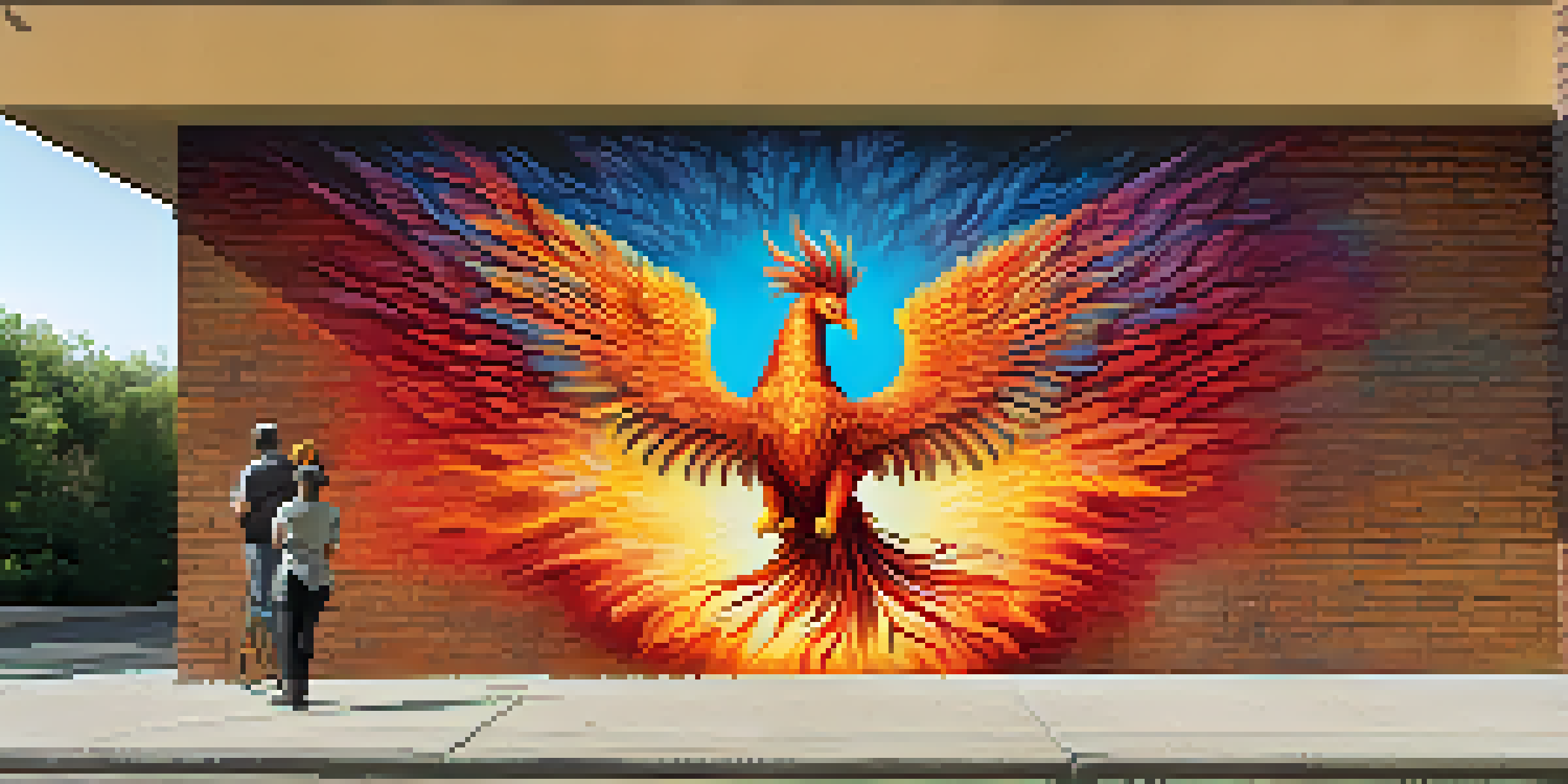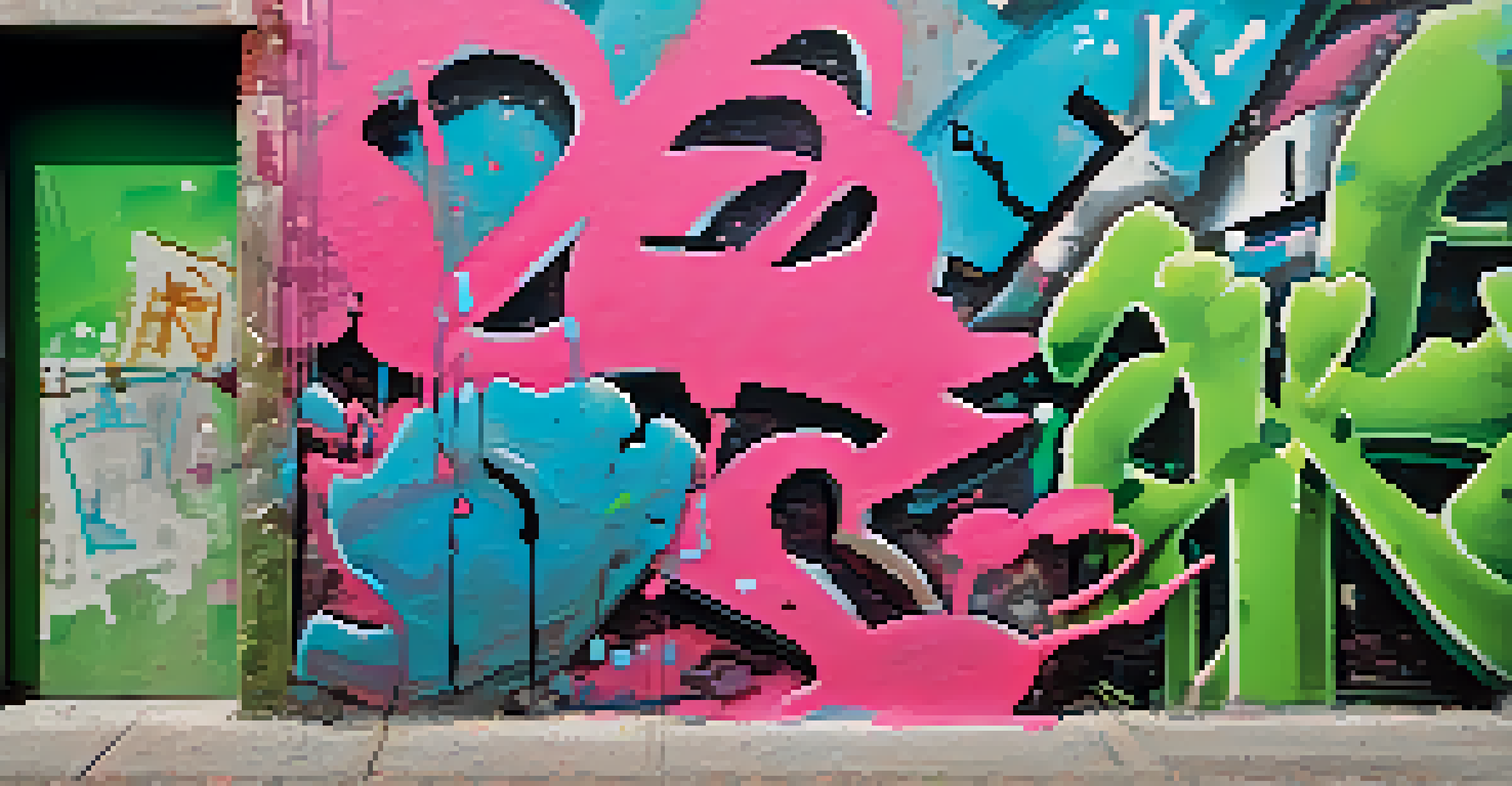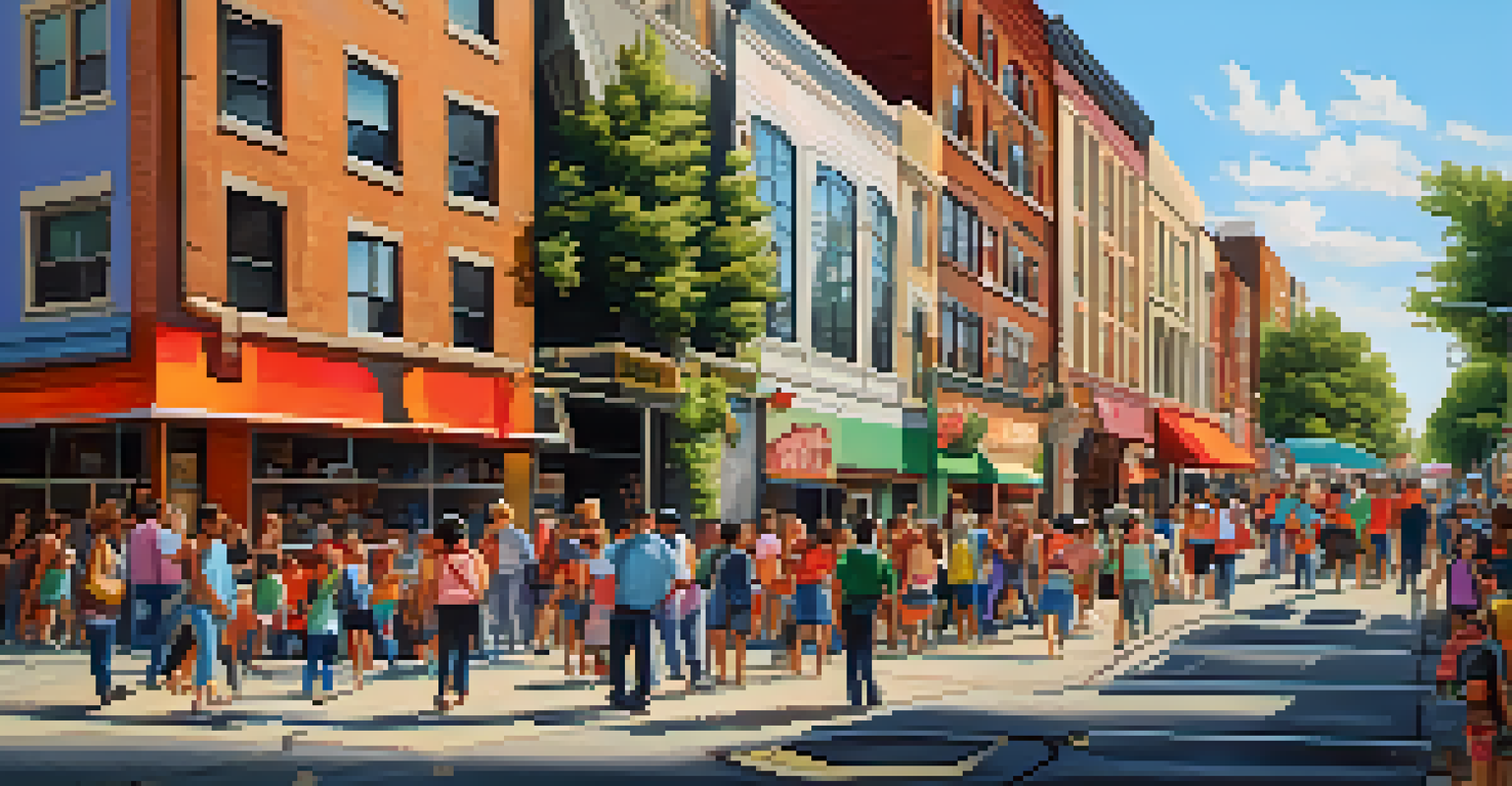Street Art vs. Graffiti: A Global Perspective on Trends

Understanding the Basics: Street Art and Graffiti Defined
At first glance, street art and graffiti may seem like two peas in a pod, but they have distinct identities. Graffiti is often characterized as a form of vandalism, typically involving tags or stylized letters, while street art encompasses a broader range of artistic expressions, including murals and stencils. Both forms thrive in urban environments, transforming blank walls into canvases, but their motivations and messages can vary widely.
Art is not a mirror to reflect the world, but a hammer with which to shape it.
Graffiti is often created in the dead of night, with the intention of claiming space or making a statement, while street artists may seek permission for their work, aiming to beautify a neighborhood or convey a social message. This difference in approach reflects the artists' intentions and how the public perceives their work. Understanding these definitions sets the stage for exploring trends in both art forms across the globe.
As we dive deeper into the world of street art and graffiti, it’s essential to appreciate the cultural contexts in which they exist. Both art forms are influenced by their surroundings, including the political climate, social issues, and community values. This backdrop plays a crucial role in shaping the evolution of street art and graffiti, making it a fascinating subject for exploration.
Historical Roots: Where Street Art and Graffiti Began
The origins of graffiti can be traced back to ancient civilizations, where people would carve or paint symbols on walls to communicate messages. Fast forward to the 1960s and 70s in New York City, graffiti exploded as a form of self-expression among marginalized youth, with the subway system becoming a gallery for their work. This period marked the birth of modern graffiti, which often included elaborate tags and stylized lettering.

On the other hand, street art as we know it today gained traction in the 1980s and 90s, influenced by the rise of the hip-hop culture and the emergence of artists like Keith Haring and Jean-Michel Basquiat. These artists utilized public spaces to create vibrant, socially charged works that challenged societal norms. This era laid the foundation for what we now recognize as street art, with its emphasis on artistic intent and public engagement.
Street Art vs. Graffiti Defined
While both art forms thrive in urban spaces, graffiti often represents vandalism with tags, whereas street art encompasses a broader range of artistic expressions and intentions.
Understanding the historical context of both art forms provides insight into their evolution and the societal factors that shaped them. From ancient times to contemporary society, graffiti and street art have consistently served as reflections of cultural identity and social commentary. As we explore modern trends, it's crucial to recognize this rich history that continues to influence artists around the world.
Cultural Significance: Street Art and Graffiti in Society
Street art and graffiti serve as powerful forms of communication, often addressing social injustices, political issues, and community narratives. Artists utilize their work to spark conversations and raise awareness about pressing matters, making their art both relevant and impactful. This cultural significance transforms walls into platforms for dialogue, inviting viewers to engage with the messages being portrayed.
The street is the only place where the people can talk back to the authority.
In many cases, street art has become a vehicle for community empowerment, allowing local artists to reclaim public spaces and express their identities. For instance, in neighborhoods facing gentrification, artists may create works that celebrate their heritage and resist displacement. This reclaiming of space fosters a sense of belonging and solidarity within the community, highlighting the positive impact of these art forms.
However, the perception of graffiti can be complex, often straddling the line between vandalism and art. While some view it as a nuisance, others appreciate its rawness and authenticity. This ongoing debate reflects broader societal attitudes towards art, ownership, and public space, emphasizing the need for understanding and dialogue around these artistic expressions.
Global Trends: How Street Art and Graffiti Are Evolving
In recent years, street art and graffiti have gained global recognition, with artists from various countries making their marks on the international stage. Cities like Berlin, Melbourne, and São Paulo have emerged as vibrant hubs for street art, attracting tourists and art enthusiasts alike. This globalization of street art has led to a rich exchange of styles and influences, creating a diverse tapestry of artistic expression worldwide.
Social media has played a pivotal role in amplifying the reach of street artists, enabling them to share their work with a broader audience. Platforms like Instagram and TikTok allow artists to showcase their creations and connect with fans, leading to increased visibility and opportunities. This digital landscape has transformed the way street art is perceived and appreciated, making it more accessible than ever before.
Cultural Impact of Street Art
Street art serves as a powerful medium for social commentary, enabling artists to address injustices and engage communities in meaningful dialogue.
Moreover, the rise of art festivals and murals has further legitimized street art within the art world. Events such as the Mural Festival in Montreal and the Urban Art Festival in Berlin celebrate the talents of street artists while fostering collaboration and community engagement. As these trends continue to evolve, they highlight the dynamic nature of street art and graffiti as a reflection of contemporary culture.
Street Art as a Tool for Activism and Change
Street art has increasingly been recognized as a powerful tool for activism, allowing artists to voice their dissent and advocate for change. From climate change to racial equality, artists use public spaces to convey urgent messages that resonate with community values. This intersection of art and activism empowers individuals to engage in critical conversations and mobilize for social justice.
One notable example is the work of Banksy, whose politically charged pieces often challenge authority and provoke thought. His art has sparked global movements, illustrating the potential of street art to influence public opinion and inspire action. By blending creativity with activism, artists can reach diverse audiences and encourage meaningful dialogue about pressing issues.
As street art continues to evolve, its role in activism becomes increasingly prominent. Artists are not only creating visually striking works but also crafting narratives that reflect the struggles and aspirations of their communities. This trend underscores the importance of art as a vehicle for social change, demonstrating that creativity can be a catalyst for transformation.
Legal Challenges: The Fine Line Between Art and Vandalism
While street art and graffiti have gained popularity, they often face significant legal hurdles. Many artists work in precarious situations, as their creations can be classified as vandalism, leading to fines or arrests. This legal ambiguity creates a challenging environment for artists, who must navigate the complexities of public spaces and property rights.
Some cities have recognized the value of street art and have implemented programs to support artists, offering designated legal walls or grants for public art projects. These initiatives aim to foster creativity while addressing concerns about vandalism and property damage. However, the tension between artists and authorities remains, as not all communities embrace street art in the same way.
Future Trends in Street Art
As technology advances and environmental awareness grows, street art is evolving to incorporate new mediums and collaborative community projects.
Understanding the legal landscape surrounding street art is crucial for both artists and supporters. By advocating for clearer policies and recognizing the cultural significance of these art forms, communities can work towards a more inclusive approach that celebrates creativity while respecting public space. This ongoing dialogue is essential for the future of street art and graffiti.
The Future of Street Art and Graffiti: Trends to Watch
Looking ahead, the future of street art and graffiti is poised for exciting developments. As technology continues to advance, artists are exploring new mediums, such as augmented reality and digital installations. This fusion of traditional and digital art opens up innovative possibilities for expression and interaction, captivating audiences in ways previously unimagined.
Additionally, the rise of environmental consciousness is influencing street art, with artists increasingly using sustainable materials and themes to address ecological issues. This trend not only highlights the importance of caring for our planet but also inspires viewers to reflect on their own impact. As street art evolves, it becomes a canvas for environmental advocacy and awareness.

Finally, as communities continue to embrace street art, we can expect to see more collaborative projects that unite artists and residents. These initiatives foster a sense of ownership and pride, transforming neighborhoods into vibrant art districts. The future of street art and graffiti is bright, promising a rich landscape of creativity and cultural expression.